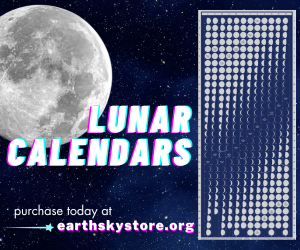Uranus at opposition on November 13, 2023
Uranus at opposition is November 13, 2023. At this time, it's brightest for the year and visible to the eye under optimum conditions. Here's how to see it.
November 12, 2023
What are red giants? Our sun will become one!
What are red giants? Most main-sequence stars, like our sun, will become one. Red giants swell to such a large size they can swallow their inner planets.
November 9, 2023
Venus in the daytime: Best ways to see it
The moon is near Venus on November 9, 2023. That makes that morning a great time to try to spot Venus in the daytime sky. Read how here.
November 8, 2023
Dark nebulae: Obscuring clouds of gas and dust
Dark nebulae are clouds of gas and dust in space. They block the light of stars shining behind them. They're often places where new stars are forming.
November 5, 2023
How big are asteroids? Compare sizes in this video
How big are asteroids? This video shows the sizes of 22 asteroids - ranging from tiny to vast - in comparison to New York City.
November 3, 2023
Jupiter and Earth just past its closest, now at opposition
Giant Jupiter is closest to Earth for 2023 on November 1-2. Then Earth will fly between the sun and Jupiter - bringing Jupiter to opposition - on November 2-3.
November 2, 2023
Year’s earliest solar noon on November 3
November 3 brings the year's earliest solar noon - that is, earliest midday - by nature's clock. It's a harbinger of the Northern Hemisphere's earliest sunset.
November 2, 2023
Why is Jupiter closest to Earth 1 day before opposition?
Jupiter's perihelion, closest point to the sun in 2023, is on November 1-2. The distance between the sun and Jupiter will be 369,964,113 miles (595,399,525 km).
November 1, 2023
Halloween is an astronomy holiday. It’s a cross-quarter day
A cross-quarter day falls between an equinox and a solstice. Halloween is the year's 4th cross-quarter day and the spookiest of the 4.
October 31, 2023
Don’t miss! Hunter’s Moon 2023 and Jupiter tonight
Find the date and time of the Northern Hemisphere's full Hunter's Moon for October 2021, and learn why this moon brightens the evening for a string of days.
October 28, 2023








